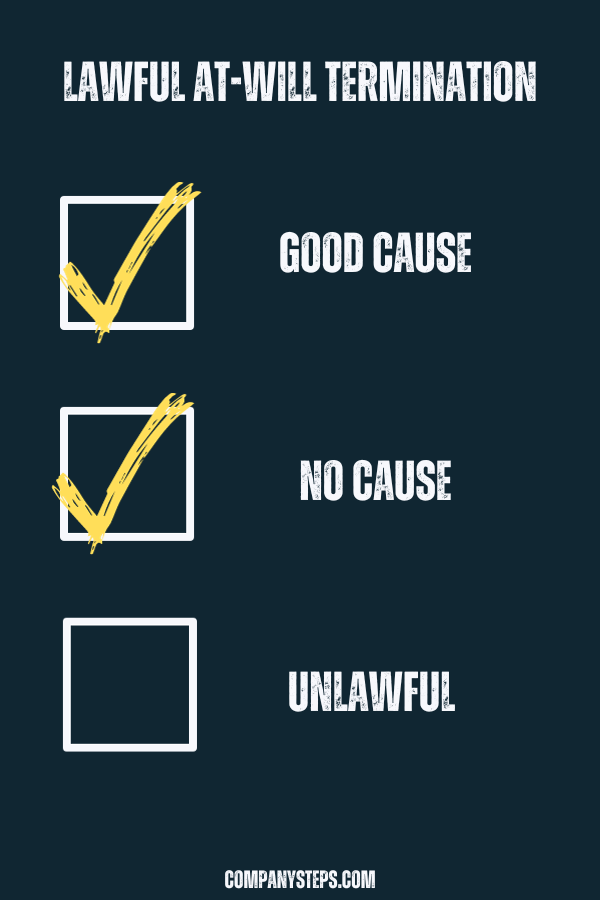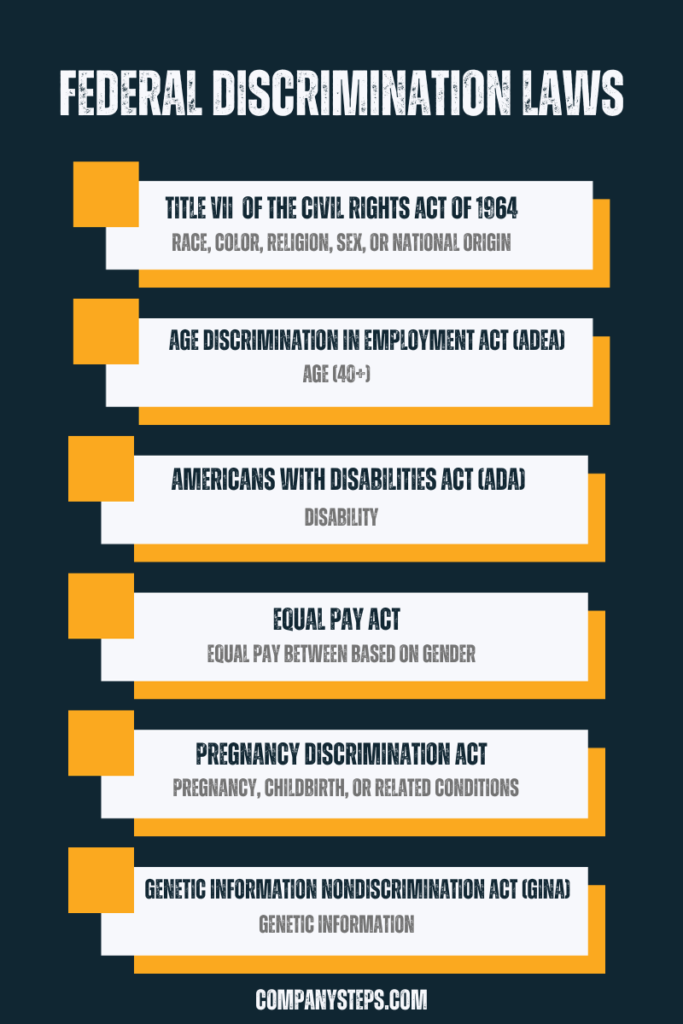Employment termination can be daunting for employers and employees. According to the Bureau of Labor Statistics, about 1.5 million Americans are terminated or laid off each month. Terminations can be a significant and costly legal trap for companies. Fortunately, Companies can ease this transition by handling terminations fairly and lawfully. Today, we will look at the laws related to employment termination and how companies can use best practices to improve the process for everyone.
At-Will Employment
Most U.S. states use the “at-will” doctrine for employment. The employment relationship can be terminated for any legal reason in an at-will employment setting.

While at-will employment provides flexibility, it also comes with risks. At-will status can make employees nervous about losing their jobs. At the same time, companies can face wrongful termination lawsuits over perceived discrimination or retaliation, even when terminating for legitimate business reasons.
Key Takeaway: At-will terminations provide flexibility for employers, but there are trade-offs.
State Law Differences
State laws can modify the at-will doctrine to be more stringent concerning terminations. For example, Montana law requires a “good cause” for termination after a probationary period. In California, employers cannot terminate employees for reasons that violate public policy, such as firing someone for filing a workers’ compensation claim.
Key Takeaway: Many states have exceptions and modifications to the at-will doctrine.
Unions and Collective Bargaining
Unionized workplaces often have collective bargaining agreements that outline specific procedures for termination, including the need for “just cause” and a defined grievance process. For example, a union contract might stipulate that an employee can only be fired after a series of disciplinary actions and an opportunity to improve.
Key Takeaway: Collective bargaining agreements will usually have restrictions on termination.
Employment Agreements
Employment agreements may specify conditions under which an employee can be terminated. Some standard provisions include failing to meet performance metrics or engaging in unethical conduct. For example, a salesperson might have a contract stating they can be terminated if they fail to meet a certain sales quota for three consecutive months.
Key Takeaway: Checking employee agreements for termination clauses is vital before dismissing someone.
Unlawful Termination
Just because a state has “At-Will” employment does not mean an employer can terminate an employee for any reason. Employment terminations must not violate state or federal law. This includes terminations due to discrimination or retaliation.
Discrimination
Discrimination is one of the most common causes of unlawful termination. Federal laws like Title VII protect employees from discrimination based on ethnicity, religion, disability, and age. Below, we will go over some of the fundamental Federal discrimination laws and regulations:

Title VII of the Civil Rights Act of 1964 – Forbids employers from discriminating against employees based on race, color, religion, sex, or national origin. This law applies to businesses with a workforce of 15 or more people.
Age Discrimination in Employment Act (ADEA) – Safeguards workers 40 or older from discrimination based on age. This law is relevant for companies that employ 20 or more individuals.
Americans with Disabilities Act (ADA) – Requires employers to provide reasonable accommodations to employees with disabilities and prohibits disability discrimination. The ADA applies to employers with 15 or more employees.
Equal Pay Act – Prohibits pay discrimination between men and women performing substantially equal work. The Equal Pay Act applies to all employers with employees.
Pregnancy Discrimination Act – Considered an amendment to Title VII, this Act prohibits discrimination based on pregnancy, childbirth, or related conditions.
Genetic Information Nondiscrimination Act (GINA) – Prohibits employment discrimination based on genetic information. GINA applies to employers with 15 or more employees.
In addition to prohibiting discriminatory terminations, these laws prohibit using discriminatory criteria in other employment actions like hiring, promotions, compensation, and layoffs. Employers must ensure employment decisions are not made due to an employee’s protected status. Note that state and local laws may expand protections to include sexual orientation, marital status, and other classes not covered federally.
Key Takeaway: Discrimination in the workplace is not only unethical but also illegal. Violations can result in lawsuits, back pay, reinstatement orders, punitive damages, and other substantial liabilities.
Reducing Legal Risks
Companies can take steps to help reduce the risk of a discrimination suit. Such steps include:
- Maintaining clear EEO and anti-retaliation policies.
- Documenting all disciplinary actions leading up to termination.
- Seeking legal counsel when terminating for sensitive reasons.
Key Takeaway: Employers that use best practices when handling employee relations will significantly reduce the likelihood of a discrimination claim.
Wrongfully Withholding Paycheck
Each state has its requirements when it comes to payday laws. In most states, however, withholding an employee’s final paycheck can lead to fines, lawsuits, and other damages. Depending on the state, this may also extend to other compensation, such as payments for earned but unpaid bonuses or commissions.
Grievances and claims against an outgoing employee do not usually allow an employer to withhold the final paycheck. Instead, the company must typically pursue its claims against an employee separately.
Potential Penalties
Wrongfully withholding a paycheck can result in severe legal consequences. These penalties can vary by state but often include fines and the possibility of being sued for the amount withheld and additional damages. For example, in California, an employer could be subject to a “waiting time penalty,” where the employee’s daily wage is paid for each day the employer is late, up to 30 days. In Texas, failure to pay final wages within six days for an involuntary termination can result in administrative penalties. Employers may also be required to pay the employee’s legal fees if the matter goes to court.
You can find links to the various state labor departments here. Each state will have information about its payday laws, including withholding paychecks.
Key Takeaway: Wrongfully withholding an employee’s paycheck can cost a company dearly.
Notices
Depending on the state or the size of the company, employers may be required to give specific notices when an employee is terminated. Such notices could include advance notice of the termination itself or information about the employee’s benefits.
State Law Notices
Some states, like New York, require employers to provide written notice of termination and the reason for termination. Failure to comply can result in penalties. State notices may be subject to strict deadlines or require specific language. Accordingly, it’s best to research your state’s notice requirements to know exactly what is required.
Federal Notices
Federal notices apply to a large portion of employers throughout the US. These notices serve to inform both the employer and the employee of their respective rights, responsibilities, and options following termination.
COBRA Notice
The Consolidated Omnibus Budget Reconciliation Act (COBRA) allows employees to continue their health coverage from 18 to 36 months after termination. It’s important to note that the employee bears the cost of this extended coverage. Applicable employers must issue a qualifying event notice within 30 days of the termination date. They must also issue a continuation notice within 14 days of the termination. Note that the Department of Labor does offer model language for these notices (see the “Regulations” tab in the link).
WARN Notice
The Worker Adjustment and Retraining Notification (WARN) Act requires employers to provide 60 days’ notice for mass layoffs or plant closures impacting over 50 employees. Failure to provide this notice can result in hefty fines.
Key Takeaway: Failure to provide required notices can result in legal consequences, including fines and potential lawsuits.
Employment Termination: The Right Way
Whether you’re an employer contemplating terminating an employee or an employee facing termination, knowledge is your best defense. Understanding and staying compliant with the applicable laws will go a long way in preventing unlawful termination claims. Not only will such practices benefit a company legally, but they can also go a long way in reducing workplace anxiety about terminations.
This article is for informational purposes and should not be considered legal advice. Always consult with a legal expert for advice tailored to your situation.
